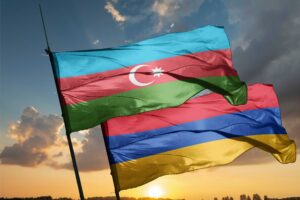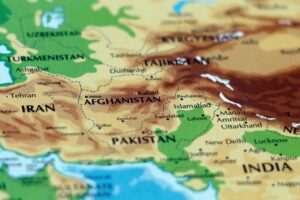The approximately 160,000 Ethiopian Israelis[i] living in the country today represent a mere 2% of the total Israeli population.[ii] However, their symbolic significance far exceeds their relative numbers. Their presence in Israel is comparatively recent, with sizeable numbers arriving only in the past 45 years. Indeed, the vast majority have reached Israel only in the past 30 or so years and more arrive every year. Moreover, about 45% of Ethiopian Israelis were born in Israel. Their situation is therefore relatively fresh, and constantly evolving and changing.
Successive governments have sought to integrate Ethiopian Israelis with the majority Jewish population.
In evaluating the minoritarian experience of Ethiopian Israelis, several structural and cultural factors must be kept in mind. Unlike Israel’s demographically large Arab Israelis or Palestinian Israelis,[iii] successive governments have sought to integrate Ethiopian Israelis with the majority Jewish population in schools, the military, and politics. While these attempts have been only partially successful, it must be emphasized that the stated goal is the complete integration of Ethiopian Israelis into the various streams of Jewish Israeli society.[iv] The homecoming of all Jews is, after all, the stated ideology of the State of Israel.
Thus, while it is common to lump Ethiopian Israelis together with other minority groups of African origin found outside the continent, any discussion of their situation in Israel must be more nuanced. Unlike most populations of the African diaspora, Ethiopian immigrants were neither brought as slaves nor allowed entry as guest workers. They did not originally arrive as students, nor were they illegally smuggled into the country (although many were illegally smuggled out of Ethiopia!). Rather, they were brought (albeit sometimes hesitantly) by the national government, often with considerable fanfare.[v] And while they clearly represent a racial and, in some senses, a religious minority, much of their history and current position in Israel must be viewed through the lens of a population who are not merely supposed to be equal citizens, but part of the dominant Jewish majority.[vi]
One obvious expression of the Ethiopians’ striving for their rightful position as part of the Jewish majority is that they have been remarkably ready to organize, demonstrate and take other political actions to demand their rights as Jewish Israelis. Whether the issue has been their religious status under Jewish and Israeli law, their mistreatment by medical or police authorities, or most commonly the rights for more of their brethren in Ethiopia to be brought to Israel, they have been vocal in their demands from successive Israeli governments.[vii]
A Gradual Opening: the History of Ethiopian Jewish Migration to Israel
For hundreds of years, a distinct community of “Ethiopian Jews”, who called themselves Beta Israel (The House of Israel) and were known to their neighbors as Falasha (landless, exiles), existed in Ethiopia. While there are passing references to this group in medieval Hebrew sources, they really only came to the attention of outside Jewry in the 18th and 19th century through the testimonies of explorers, missionaries and, eventually, emissaries sent to contact them.
Their Judaism was a non-Talmudic Old Testament based religion, heavily influenced by Ethiopian Orthodox Christianity. Thus the Beta Israel had priests (kahenat), not rabbis, did not celebrate later holidays such as Chanukah or Purim, and had the Bible only in Ge’ez (Ethiopic). They also used Ge’ez for their prayer liturgy and in several apocryphal books not known to other Jewish communities. In the 19th century, they were recognized by many rabbis and several European organizations as a “lost tribe” of Jews and, particularly in the early 20th century, activities began to reconnect them with other Jews. The activist and scholar Jacques (Ya’acov) Faitlovitch set up schools in Ethiopia and brought a small number of young men to Europe and Palestinian territories to awaken interest in their existence.
Until the late 1970s, Ethiopian Jews were denied the right to enter Israel as immigrants.
When the State of Israel was founded in 1948, Ethiopians were not brought there like survivors of the Holocaust and many Jews from Arab lands. Until the late 1970s, Ethiopian Jews were denied the right to enter Israel as immigrants. Israeli government authorities cited questions regarding their Jewishness, the need to preserve strong ties with Ethiopia, the huge economic-cultural gap between rural Ethiopia and urban Israeli society, and (at least in closed discussions) their race. However, in the 1950s a few dozen were brought to Israel to study for a short period.
In addition, small numbers of Israeli and Jewish representatives visited Ethiopia and gradually awakened the interest of the Beta Israel in aliyah, or emigration. In England, a Falasha Welfare Association was founded in an attempt to improve the situation of the Beta Israel in Ethiopia. On the other side of the Atlantic, the American Association for Ethiopian Jews began to pressure the Israeli government to be more proactive in bringing the Ethiopians to Israel. The Americans saw pro-Ethiopian activity as a vehicle to counter claims that Zionism was racism and to repair rifts which had emerged between American Jews and African Americans.
In 1977, the Israeli Parliament voted to grant the Beta Israel the right to come to Israel under the “Law of Return”, which granted all Jews sanctuary in the country.
In the 1970s, the decisions of Israel’s chief rabbis as well as its Knesset resolved several thorny issues regarding the Jewishness of the Beta Israel. The Sephardi Chief Rabbi, Ovadia Yosef ruled, based on a 16th century precedent, that the Ethiopians were Jews from the lost tribe of Dan. His Ashkenazi counterpart was more cautious, but accepted that they suffered in Ethiopia as Jews and should be assisted. In 1977, the Israeli Parliament voted to grant the Beta Israel the right to come to Israel under the “Law of Return”, which granted all Jews sanctuary in the country. Gradually, in the late 1970s and early 1980s, efforts to bring Ethiopian immigrants to Israel intensified by both the Israeli government and private organizations. Among younger members of the Beta Israel, increased awareness about modern Israel and their distress in Ethiopia combined to raise hopes and expectations of a move to Israel. The small numbers of young people who reached Israel did not forget their kin in Ethiopia and began pioneer paths out of Ethiopia. The pace of migration was never satisfactory to the immigrants and their supporters, and the number of people in Ethiopia claiming to be Beta Israel or their relatives, or descendants continued to grow.
As their numbers in Israel grew, there were always Ethiopians waiting to come to the country and Ethiopian Israelis demonstrated to demand they be brought.[viii] With each successive wave, and there were dramatic airlifts in 1983 and 1991, it was announced that the last Ethiopian Jews had been brought, only to have more “discovered” and renewed demands to bring them arise. For their part, successive Israeli governments took a gradualist approach whereby they never totally accepted all of those waiting to leave Ethiopia and were slow even in bringing those it was agreed should be brought. Pictures of Ethiopian Israelis carrying photographs of relatives still stuck in Ethiopia became a standard feature of pro-migration demonstrations, even as a population estimated at 30,000 in the 1970s rose to many times that number. As Ethiopia struggled through political chaos with dramatic changes in government, famines and civil war, hundreds of thousands of Ethiopians fled the country. For those of Jewish descent, Israel was the obvious safe haven.
Once in Israel: Borderline Status and Efforts Towards Improved Integration
At the same time, from 1985 onwards, Ethiopian Israelis began to organize to assert their rights in Israel as well. At the time, Ethiopian immigrants were broadly recognized as Jews, and hence under the authority of the Israeli Chief Rabbinate. However, they faced questions about their personal status (marriages, divorces, etc.) because they had not practiced rabbinic law in Ethiopia. Thus, even when they numbered only a few thousand, a long peaceful protest was conducted outside the Israeli chief rabbinate in Jerusalem to demand their full recognition as Jews.[ix] This issue was eventually resolved with a large majority of Israeli rabbinic authorities accepting the Jewishness of the Ethiopians. However, it remains a long-standing sore point. To not be recognized or perceived as fully Jewish in the Jewish state is a grave insult.
One expression of this borderline status is that there are often conflicts on the local level regarding admission of Ethiopian students to schools (Israeli schools have separate tracks for secular, traditional, orthodox, and ultra-orthodox Jews, as well as for Hebrew education and Arabic education). Initially, Ethiopian immigrants were overwhelmingly tracked to religious schools and, in the case of older students, boarding school. Not only did this limit their options, but it also overwhelmed particular schools, while others could play no part in the effort to integrate and educate them. They were also disproportionately tracked into vocational schools and special education.[x]
The share of students of Ethiopian origin holding a matriculation certificate that met university entrance requirements is still only 48%, compared with 73.1% of the total number of students in the Hebrew education sector.
Over time, most of these policies were discontinued and they came to more broadly reflect the cities and neighbourhoods where they resided. To this day, however, the share of students of Ethiopian origin holding a matriculation certificate that met university entrance requirements (i.e., the percentage of potential candidates for continued study at institutions of higher education) is still only 48%, compared with 73.1% of the total number of students in the Hebrew education sector. However, it should be noted that this percentage improves from year to year.
In this context, it should also be noted that Ethiopian women have generally integrated more successfully than the men. The percentage of Ethiopian men who marry non-Ethiopians is about 10%, while among women it is already 17%. This latter figure is in keeping with other transformations of the role of women from Ethiopia due to urbanization, access to work outside the home and the subsequent rise in income, and, perhaps most importantly, education. Not only are Ethiopian girls more likely to complete high school, but Ethiopian women go on to college and even graduate studies in much higher numbers than the men.
These improvements must certainly be borne in mind in light of the widespread but erroneous claims that the dramatic decline in the birthrate among Ethiopians has taken place because of the forced administration of dangerous forms of birth control.[xi] Despite the widespread public outcry regarding a “lost generation of children”, the downward trend can be totally explained as a by-product of the changes alluded to above. In Israel, Ethiopian women marry later, become mothers later, and stop reproducing at a younger age than in Ethiopia. As of 2020, among women of Ethiopian origin, the average age at first marriage was 27.9 (2.3 years older than Israeli Jewish brides and well more than a decade later than the practice in Ethiopia). In 2020, the age at first birth among women of Ethiopian origin was 28.6 years.
Dark Chapters and Fraught Relations
One reason why so many were willing to accept the claim of a conspiracy by medical authorities against the Ethiopians was that in 1996 it was revealed that blood donated by Ethiopian immigrants was discarded by the Magen David Adom (the Israel affiliate of the Red Cross and Red Crescent) because of a fear that a high percentage of Ethiopians who arrived after 1991 carried the HIV virus.[xii] Government officials claimed that the decision to keep this policy secret was borne of a desire to prevent the stigmatization of Ethiopians. However, it was widely viewed by the public as racist and a betrayal. Later research claimed that the policy would have eliminated at most an insignificant number of infections. [xiii] Certainly, the image of Black Africans as disease carriers who threatened the health of the nation was devastating to Ethiopian Israelis and for the first time, but not the last, they responded with violent demonstrations.
Although 25 years have passed since the Blood Scandal, many continue to view it as a turning point in relations between Ethiopian Israelis and the state. Certainly, there is a continued legacy of distrust.
Ethiopian men and youth are charged in court for theft, violent acts and disturbing the peace in numbers that are disproportionate with their numbers in the overall population.
However, in recent years, the most troubling issue for many Ethiopian Israelis has been their relationship with the justice system and the police. Ethiopian men and youth are charged in court for theft, violent acts and disturbing the peace in numbers that are disproportionate with their numbers in the overall population. Moreover, there have been several particularly troubling incidents of violence perpetrated by the police against Ethiopians, including the videotaped beating of a soldier and the killing of a teen by an off-duty policeman. While officials have been quick to condemn these,[xiv] charges of racist policing and Black (Ethiopian) Lives Matter have figured in many demonstrations. [xv]
Conclusion
45 years after the first Ethiopian immigrants were officially brought to Israel, the standing of the more than 160,000 Ethiopian Israelis remains precarious. While it is easy to point to both communal and individual successes, troubling phenomena persist both within the Ethiopian community, and between Ethiopian Israelis and other Israelis. It is unlikely that there will be a clear resolution of this minority within the Jewish majority in the coming years.
[i] I have chosen the term Ethiopian Israelis to avoid getting into the vexed question of the religious status of many individuals.
[ii] Unless otherwise noted all statistics in this article are based on the Israeli Central Bureau of Statistics’ report released on November 11, 2021, which is accessible here <https://www.enp.org.il/pics/database/more_data/cbs-english-13667-1j56ivzlfbnd08auw9bu.pdf>. For the most recent of several overviews on Ethiopian Israelis see Steven Kaplan and Hagar Salamon, “Ethiopian Immigrants in their Israeli Context: Some Introductory Framings,” in Eliezer Witztum and Nimro Grisaru eds. Social, Cultural and Clinical Aspects of Ethiopian Immigrants in Israel, (Beer-Sheva, The Jewish Agency for Israel and Ben Gurion University of the Negev Press, 2014), 21-36.
[iii] educationinequalityinisraeleng.pdf (taubcenter.org.il) I am referring here to those within the pre-1967 Israeli borders.
[iv] Kaplan, Steven. “Black and white, blue and white and beyond the pale: Ethiopian Jews and the discourse of colour in Israel.” Jewish culture and history 5, no. 1 (2002): 51-68. It should also be noted that in Ethiopia, Beta Israel, like other northern Ethiopians did not consider themselves to be black, but rather reddish brown. Blacks were southern Ethiopians or neighboring Africans such as Sudanese, Kenyans or Somalis. Thus, much of their experience in Israel must be understood not as one of “being black” but of becoming black in their encounter with Israeli society. See: Salamon, Hagar. “Blackness in transition: Decoding racial constructs through stories of Ethiopian Jews.” Journal of folklore research 40, no. 1 (2003): 3-32.
[v] Spector, Stephen. Operation Solomon: the daring rescue of the Ethiopian Jews. Oxford University Press, 2005. Louis Rapoport, Redemption Song: The Story of Operation Moses, Harcourt, 1986.
[vi] In this respect I strongly disagree with the perspective of, among others, Jordan, Holly A. “Black, Poor and Jewish: The Ostracism of Ethiopian Jews in Modern Israel.” In Migration Policy and Practice, pp. 175-190. Palgrave Macmillan, New York, 2016.
[vii] Burstein, Alon, and Liora Norwich. “From a whisper to a scream: The politicization of the Ethiopian community in Israel.” Israel Studies 23, no. 2 (2018): 25-50.
[viii] The saga of Ethiopian aliyah – The Jerusalem Post (jpost.com)
[ix]See my article Kaplan, Steven. “The Beta Israel and the Rabbinate: law, ritual and politics.” Social Science Information 27, no. 3 (1988): 357-370.
[x] For an early study of these policies see Wagaw, Teshome G. For Our Soul: Ethiopian Jews in Israel. Wayne State University Press, 1993.
[xi] See Steven Kaplan, “Birth and Control: Ethiopian Jewish Women Forty Years Later,” in Ingrid T. Monson, Carol J. Oja, and Richard K. Wolf eds. Out of Bounds: Ethnography, History, Music. Essays in honor of Kay Kaufman Shelemay, (Cambridge, MA and London, Harvard University Press, 2017), 125-142.
[xii] Seeman, Don. ““One people, one blood”: public health, political violence, and HIV in an Ethiopian-Israeli setting.” Culture, Medicine and Psychiatry 23, no. 2 (1999): 159-195. WEIL, SHAIVA. “Religion, blood and the equality of rights the case of Ethiopian Jews in Israel.” İsrael Social Science Research 10 (1997): 25-40.
[xiii]Kaplan, Edward H. “Israel’s ban on use of Ethiopians’ blood: how many infectious donations were prevented?.” The Lancet 351, no. 9109 (1998): 1127-1128.
[xiv] Thus, when an Ethiopian Israeli soldier Damas Fekade was beaten by Israeli police the then Prime Minister Benjamin Netanyahu met personally with him and decried the existence of racism in the country. “We must stand together as one against the phenomenon of racism, to denounce it and eliminate it,” he said. (It should be noted that Netanyahu’s anti-racist posture did not appear to apply to either African asylum seekers or the country’s Arab population!).
[xv] Brutality against Ethiopian Israelis has reached a state of emergency – Opinion – Haaretz.com
















